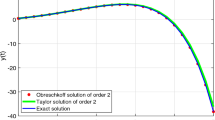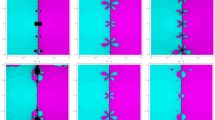Abstract
Strong stability preserving (SSP) time discretizations preserve the monotonicity properties satisfied by the spatial discretization when coupled with the first order forward Euler, under a certain time-step restriction. The search for high order strong stability preserving time-stepping methods with high order and large allowable time-step has been an active area of research. It is known that implicit SSP Runge–Kutta methods exist only up to sixth order; however, if we restrict ourselves to solving only linear autonomous problems, the order conditions simplify and we can find implicit SSP Runge–Kutta methods of any linear order. In the current work we find implicit SSP Runge–Kutta methods with high linear order \(p_{lin} \le 9\) and nonlinear orders \(p=2,3,4\), that are optimal in terms of allowable SSP time-step. Next, we formulate a novel optimization problem for implicit–explicit (IMEX) SSP Runge–Kutta methods and find optimized IMEX SSP Runge–Kutta pairs that have high linear order \(p_{lin} \le 7\) and nonlinear orders up to \(p=4\). We also find implicit methods with large linear stability regions that pair with known explicit SSP Runge–Kutta methods. These methods are then tested on sample problems to demonstrate the sharpness of the SSP coefficient and the typical behavior of these methods on test problems.





Similar content being viewed by others
References
Ascher, U., Ruuth, S., Wetton, B.: Implicit–explicit methods for time-dependent partial differential equations. SIAM J. Numer. Anal. 32, 797–823 (1995)
Ascher, U.M., Ruuth, S.J., Spiteri, R.J.: Implicit–explicit Runge–Kutta methods for time-dependent partial differential equations. Appl. Numer. Math. 25, 151–167 (1997). (Special Issue on Time Integration)
Boscarino, S., Pareschi, L., Russo, G.: Implicit–explicit Runge–Kutta schemes for hyperbolic systems and kinetic equations in the diffusion limit. SIAM J. Sci. Comput. 35, A22–A51 (2013)
Butcher, J.C.: Numerical Methods for Ordinary Differential Equations. Wiley, New York (2016)
Calvo, M., de Frutos, J., Novo, J.: Linearly implicit Runge–Kutta methods for advection–reaction–diffusion equations. Appl. Numer. Math. 37, 535–549 (2001)
Christlieb, A.J., Gottlieb, S., Grant, Z., Seal, D.C.: Explicit strong stability preserving multistage two-derivative time-stepping schemes. J. Sci. Comput. 68, 914–942 (2016)
Conde, S., Gottlieb, S., Grant, Z.: Optimal strong stability preserving implicit linear/nonlinear methods. https://github.com/SSPmethods/ImplicitLNLMethods
Conde, S., Gottlieb, S., Grant, Z.: Optimized strong stability preserving imex methods. https://github.com/SSPmethods/imexLNL
Crouzeix, M.: Une m’ethode multipas implicite–explicite pour l’approximation des equations d’evolution paraboliques. Numerische Mathematik 35, 257–276 (1980)
Ferracina, L., Spijker, M.N.: Stepsize restrictions for the total-variation-diminishing property in general Runge–Kutta methods. SIAM J. Numer. Anal. 42, 1073–1093 (2004)
Ferracina, L., Spijker, M.N.: An extension and analysis of the Shu–Osher representation of Runge–Kutta methods. Math. Comput. 249, 201–219 (2005)
Gottlieb, S., Grant, Z., Higgs, D.: Optimal explicit strong stability preserving Runge–Kutta methods with high linear order and optimal nonlinear order. Math. Comput. 84, 2743–2761 (2015)
Gottlieb, S., Ketcheson, D.I., Shu, C.-W.: Strong Stability Preserving Runge–Kutta and Multistep Time Discretizations. World Scientific Press, London (2011)
Higueras, I.: On strong stability preserving time discretization methods. J. Sci. Comput. 21, 193–223 (2004)
Higueras, I.: Representations of Runge–Kutta methods and strong stability preserving methods. SIAM J. Numer. Anal. 43, 924–948 (2005)
Higueras, I.: Strong stability for additive Runge–Kutta methods. SIAM J. Numer. Anal. 44, 1735–1758 (2006)
Higueras, I.: Characterizing strong stability preserving additive Runge–Kutta methods. J. Sci. Comput. 39, 115–128 (2009)
Higueras, I., Happenhofer, N., Koch, O., Kupka, F.: Optimized strong stability preserving IMEX Runge–Kutta methods. J. Comput. Appl. Math. 272, 116–140 (2014)
Kennedy, C., Carpenter, M.: Additive Runge–Kutta schemes for convection–diffusion–reaction equations. Appl. Numer. Math. 44, 139–181 (2003)
Ketcheson, D.I.: Highly efficient strong stability preserving Runge–Kutta methods with low-storage implementations. SIAM J. Sci. Comput. 30, 2113–2136 (2008)
Ketcheson, D.I.: Runge–Kutta methods with minimum storage implementations. J. Comput. Phys. 229, 1763–1773 (2010)
Ketcheson, D.I., Gottlieb, S., Macdonald, C.B.: Strong stability preserving two-step Runge–Kutta methods. SIAM J. Numer. Anal. 49, 2618–2639 (2012)
Ketcheson, D.I., Macdonald, C.B., Gottlieb, S.: Optimal implicit strong stability preserving Runge–Kutta methods. Appl. Numer. Math. 52, 373 (2009)
Ketcheson, D.I., Parsani, M., Ahmadia, A.J.: RK-opt: software for the design of Runge–Kutta methods, version 0.2. https://github.com/ketch/RK-opt
Kraaijevanger, J.F.B.M.: Contractivity of Runge–Kutta methods. BIT 31, 482–528 (1991)
Kubatko, E.J., Yeager, B.A., Ketcheson, D.I.: Optimal strong-stability-preserving Runge–Kutta time discretizations for discontinuous galerkin methods. J. Sci. Comput. 60, 313–344 (2014)
Kupka, F., Happenhofer, N., Higueras, I., Koch, O.: Total-variation-diminishing implicit–explicit Runge–Kutta methods for the simulation of double-diffusive convection in astrophysics. J. Comput. Phys. 231, 3561–3586 (2012)
Pareschi, L., Russo, G.: Implicit–explicit Runge–Kutta schemes and applications to hyperbolic systems with relaxation. J. Sci. Comput. 25, 129–155 (2005)
Ruuth, S.J., Spiteri, R.J.: Two barriers on strong-stability-preserving time discretization methods. J. Sci. Comput. 17, 211–220 (2002)
Shu, C.-W.: Total-variation diminishing time discretizations. SIAM J. Sci. Stat. Comput. 9, 1073–1084 (1988)
Shu, C.-W., Osher, S.: Efficient implementation of essentially non-oscillatory shock-capturing schemes. J. Comput. Phys. 77, 439–471 (1988)
Spiteri, R.J., Ruuth, S.J.: A new class of optimal high-order strong-stability-preserving time discretization methods. SIAM J. Numer. Anal. 40, 469–491 (2002)
Acknowledgements
The authors wish to thank the anonymous referees whose careful reading and insightful comments dramatically improved this manuscript. This work was supported by AFOSR Grant FA9550-15-1-0235, and was partially supported by DOE NNSA ASC Algorithms effort, the DOE Office of Science AMR program at Sandia National Laboratory under contract DE-AC04-94AL85000.
Author information
Authors and Affiliations
Corresponding author
Rights and permissions
About this article
Cite this article
Conde, S., Gottlieb, S., Grant, Z.J. et al. Implicit and Implicit–Explicit Strong Stability Preserving Runge–Kutta Methods with High Linear Order. J Sci Comput 73, 667–690 (2017). https://doi.org/10.1007/s10915-017-0560-2
Received:
Revised:
Accepted:
Published:
Issue Date:
DOI: https://doi.org/10.1007/s10915-017-0560-2




